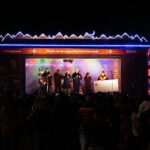Home »

Three prescribed burns scheduled in April
Weather and ground conditions permitting, three prescribed burns will be ignited this month to restore grasslands and open forests on Crown land and at Premier Lake Provincial Park.
BC Parks and the Rocky Mountain Trench Ecosystem Restoration Program have planned low-intensity controlled fires at the following sites:

• 156 hectares at the junction of Hwys 95 and 3/93 near Isadore’s Canyon northeast of Cranbrook. Motorists are advised that smoke may drift onto the highway. Traffic control will be in place on the day of the burn.
• 166 hectares south of Ta Ta Creek in the vicinity of the old Kimberley Airport on Hwy 95A. The public is asked to avoid using this popular recreation area while burning is underway.
• 150 hectares in the Yankee-Canuck Lakes area on the east side of Premier Lake Provincial Park. The public is advised that hiking trails in this area will be closed during the burn.
Ecosystem restoration projects have been ongoing at all three sites for several years.
Initial thinning treatments have now reduced forest stands to the point where restorative fire can be introduced safely and effectively.
Local crews from the provincial Wildfire Management Branch Southeast Fire Centre will conduct the burns using plans prepared to achieve specific objectives for each fire.
The Premier Lake burn will restore two endangered plant communities and improve wildlife habitat. The burn near Cranbrook will reduce a fire hazard created when an infestation of false hemlock looper killed fir trees. The old airport burn will improve grazing for elk and cattle and will enhance habitat for badgers, an endangered species.
Each fire will be ignited only when weather conditions meet B.C.’s smoke control regulations and when ground conditions allow fires to be managed safely.
Prescribed burns mimic the frequent low-intensity ground fires that historically maintained grasslands and open forests in the East Kootenay and Upper Columbia Valley.
Prescribed fire controls tree regeneration, recycles soil nutrients, rejuvenates bunchgrasses and shrubs, improves forest health, and reduces the risk of more severe wildfire.
Funding for this season’s prescribed burns is provided by the Habitat Conservation Trust Foundation and the B.C. government’s Land Based Investment program.
The Rocky Mountain Trench Ecosystem Restoration Program (Trench ER Program) has operated as a successful partnership of government, industry and the public since 1998.
The long-term goal is to restore East Kootenay/Upper Columbia Valley grasslands and open forests to their former fire-maintained condition.
Restoration treatments include thinning forest ingrowth and re-introducing fire to the landscape via controlled burns. Restoration is taking place on Crown land, in provincial and national parks, on private conservation properties and First Nations reserves from Radium Hot Springs to the U.S. border.
Restoring grasslands and open forests enhances biodiversity; restores habitat for species at risk; improves natural grazing for domestic cattle, elk, deer and bighorn sheep; improves forest health; and reduces the risk of severe wildfire.
Visit www.trench-er.com to learn more about ecosystem restoration in the Rocky Mountain Trench.
Above photo: A prescribed burn at Premier Lake Provincial Park in 2010.
Susan Bond, Rocky Mountain Trench Ecosystem Restoration Program







